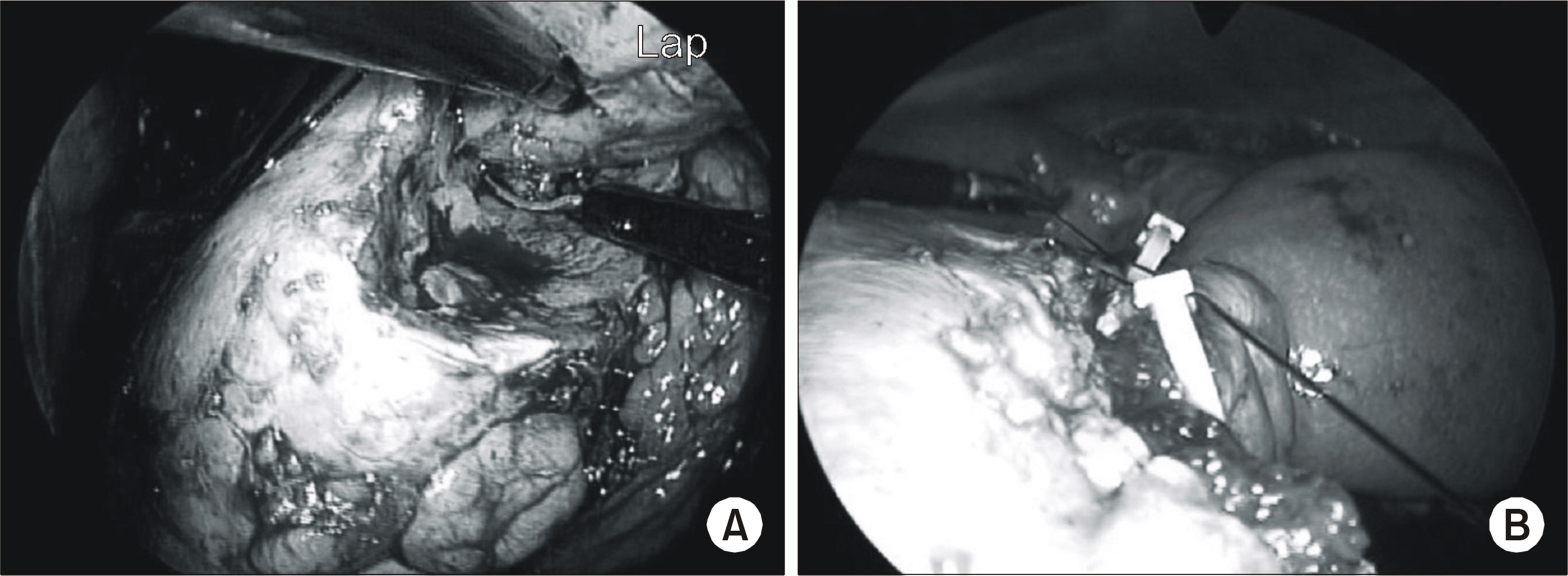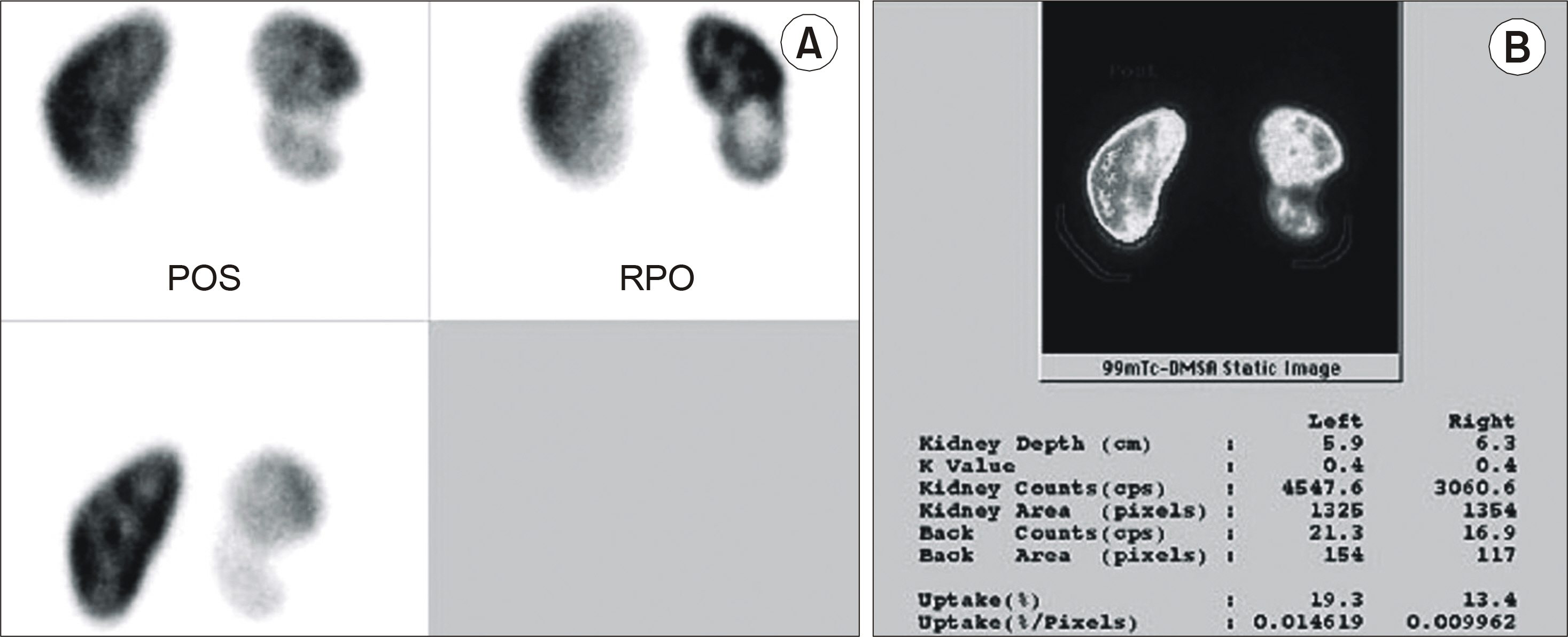Korean J Urol.
2006 Dec;47(12):1256-1262. 10.4111/kju.2006.47.12.1256.
Laparoscopic Partial Nephrectomy for the 4cm or Less Renal Tumors
- Affiliations
-
- 1Department of Urology, College of Medicine, The Catholic University of Korea, Seoul, Korea. tkhwang@catholic.ac.kr
- KMID: 2139768
- DOI: http://doi.org/10.4111/kju.2006.47.12.1256
Abstract
- PURPOSE
The popularity of a partial nephrectomy has grown as a consequence of the increased detection of small incidental renal masses. Herein, our experience of laparoscopic partial nephrectomies is reported. MATERIAL AND METHODS: Between December 2003 and April 2006, 27 cases underwent a laparoscopic partial nephrectomy for renal tumors up to 4cm in diameter. The tumors, and an approximate 0.5cm margin around the tumors, were resected with cold scissors. Hemostasis was achieved with freehand suturing of the pelvocalyceal system and renal parenchyme, over the surgical bolster, using fibrin glue.
RESULTS
Transperitoneal and retroperitoneal approaches were chosen in 14 and 13 cases, respectively. Hilar clamping of small exophytic tumors was performed in all but 3 cases, with minimal parenchymal invasion. The mean renal tumor size was 2.5cm (ranging from 1 to 4cm). The mean operative and warm ischemia times, and blood loss were 193 minutes (ranging from 115 to 300) and 27.8 minutes (ranging from 15 to 43), and 493ml (ranging from 32 to 1,248), respectively. The mean hospitalization stay was 5.2 days (ranging from 3 to 8 days). Conversion to a laparoscopic radical nephrectomy was required in one case due to a positive frozen biopsy of the resection bed. There were no perioperative complications or open conversions. Histological examinations yielded a renal cell carcinoma in 20 cases, an angiomyolipoma or oncocytoma in 2 cases each, a lipoma in 1 and a leiomyosarcom in 2 cases, two of which had positive margins. One patient underwent selective angioembolization for an asymptomatic renal artery pseudoaneurysm three months postoperatively. All patients were alive, without any local recurrence or metastatic disease, at a mean follow up of 11.4 months (ranging from 3 to 24 months).
CONCLUSIONS
A laparoscopic partial nephrectomy can be performed safely. However, long-term follow-up is required to compare its cancer control with that of an open partial nephrectomy.
Keyword
MeSH Terms
Figure
Cited by 2 articles
-
A Feasible Technique for Transient Vascular Occlusion by Using a Vessel Loop and Hem-o-Lok Clips in Laparoscopic Partial Nephrectomy
Yoon Hyung Lee, Joon Beom Kwon, Sung Ryong Cho, Jae Soo Kim
Korean J Urol. 2011;52(8):543-547. doi: 10.4111/kju.2011.52.8.543.Laparoscopic Partial Nephrectomy: An Useful Method of Decision Making for Determining the Approach and Surgical Method Based on the Systematic Classification of Tumor Location
Kyung Yun Kim, Seung-Hyo Woo, Eun Tak Kim, Seung Bae Lee, Dae Kyung Kim
Korean J Urol. 2008;49(12):1067-1073. doi: 10.4111/kju.2008.49.12.1067.
Reference
-
1.Clayman RV., Kavoussi LR., Soper NJ., Dierks SM., Meretyk S., Darcy MD, et al. Laparoscopic nephrectomy: initial case report. J Urol. 1991. 146:278–82.
Article2.Lightfoot N., Conlon M., Kreiger N., Bissett R., Desai M., Warde P, et al. Impact of noninvasive imaging on increased incidental detection of renal cell carcinoma. Eur Urol. 2000. 37:521–7.
Article3.Hankey BF., Feuer EJ., Clegg LX., Hayes RB., Legler JM., Prorok PC, et al. Cancer surveillance series: interpreting trends in prostate cancer part I: evidence of the effects of screening in recent prostate cancer incidence, mortality, and survival rates. J Natl Cancer Inst. 1999. 91:1017–24.4.McKieman J., Simmons R., Katz J., Russo P. Natural history of chronic renal insufficiency after partial and radical nephrectomy. Urology. 2002. 59:816–20.
Article5.McDougall EM., Clayman RV., Anderson K. Laparoscopic wedge resection of a renal tumor: initial experience. J Laparoendosc Surg. 1993. 3:577–81.
Article6.Moinzadeh A., Gill IS., Finelli A., Kaouk J., Desai M. Laparoscopic partial nephrectomy: 3-year followup. J Urol. 2006. 175:459–62.
Article7.Gaur DD. Laparoscopic operative retroperitoneoscopy: use of a new device. J Urol. 1992. 148:1137–9.
Article8.Guillonneau B., Bermudez H., Gholami S., El Fettouh H., Gupta R., Adomo Rosa J, et al. Laparoscopic partial nephrectomy for renal tumor: single center experience comparing clamping and no clamping techniques of the renal vasculature. J Urol. 2003. 169:483–6.9.Singh D., Rubenstein M., Gill IS. Laparoscopic partial nephrec tomy. J Endourol. 2005. 19:451–5.10.Novick AC. Surgery of die kidney. Walsh PC, Retik AB, Vaughan ED, Wein AJ, editors. editors.Campbell' s urology. 8th ed.Philadelphia: Saunders;2002. p. 3602–13.11.Finelli A., Gill IS. Laparoscopic partial nephrectomy: contemporary technique and results. Urol Oncol. 2004. 22:139–44.
Article12.Nguyen TT., Parkinson JP., Kuehn DM., Winfield HN. Technique for ensuring negative surgical margins during laparoscopic partial nephrectomy. J Endourol. 2005. 19:410–5.
Article13.Timsit MO., Bazin JP., Thiounn N., Fontaine E., Chretien Y., Dufour B, et al. Prospective study of safety margins in partial nephrectomy: intraoperative assessment and contribution of frozen section analysis. Urology. 2006. 67:923–6.
Article14.Zucchi A., Mearini L., Mearini E., Costantini E., Vivacqua C., Porena M. Renal cell carcinoma: histological findings on surgical margins after nephron sparing surgery. J Urol. 2003. 169:905–8.
Article15.Li QL., Guan HW., Zhang QP., Zhang LZ., Wang FP., Liu YJ. Optimal margin in nephron-sparing surgery for renal cell carcinoma 4cm or less. Eur Urol. 2003. 44:448–51.16.Castilla EA., Liou LS., Abrahams NA., Fergany A., Rybicki LA., Myles J, et al. Prognostic importance of resection margin width after nephron-sparing surgery for renal cell carcinoma. Urology. 2002. 60:993–7.
Article17.Novick AC. Nephron-sparing surgery for renal cell carcinoma. Annu Rev Med. 2002. 53:393–407.
Article18.Dimarco DS., Lohse CM., Zincke H., Cheville JC., Blute ML. Long-term survival of patients with unilateral sporadic multifocal renal cell carcinoma according to histologic subtype compared with patients with solitary tumors after radical nephrectomy. Urology. 2004. 64:462–7.
Article19.Van PH. Nephron sparing surgery in renal cell carcinoma. Braz J Urol. 2000. 26:342–53.20.Orvieto MA., Chien GW., Laven B., Rapp DE., Sokolo伴Μ Η., Shalhav AL. Eliminating knot tying during warm ischemia time for laparoscopic partial nephrectomy. J Urol. 2004. 172:2292–5.
Article21.Albani JM., Novick AC. Renal artery pseudoaneurysm after partial nephrectomy: three case reports and a literature review. Urology. 2003. 62:227.
Article22.Gill IS., Abreu SC., Desai MM., Steinberg AP., Ramani AP., Ng C, et al. Laparoscopic ice slush renal hypothermia for partial nephrectomy: the initial experience. J Urol. 2003. 170:52–6.
Article23.Landman J., Venkatesh R., Lee D., Vanlangendonck R., Morissey K., Andriole GL, et al. Renal hypothermia achieved by retrograde endoscopic cold saline perfusion: technique and initial clinical application. Urology. 2003. 61:1023–5.
Article24.Ward JP. Determination of the optimum temperature for regional renal hypothermia during temporary renal ischaemia. Br J Urol. 1975. 47:17–24.
Article
- Full Text Links
- Actions
-
Cited
- CITED
-
- Close
- Share
- Similar articles
-
- Laparoscopic Partial Nephrectomy using a Microwave Tissue Coagulator for Small Renal Tumor
- Current Status of Partial Nephrectomy for Renal Mass
- Percutaneous Embolization of Renal Artery Pseudoaneurysm after Laparoscopic Partial Nephrectomy for Renal Cell Carcinoma
- Analysis of Surgical Results of Laparoscopic Partial Nephrectomy for Endophytic Renal Tumor
- Current Status of Laparoscopic Partial Nephrectomy





